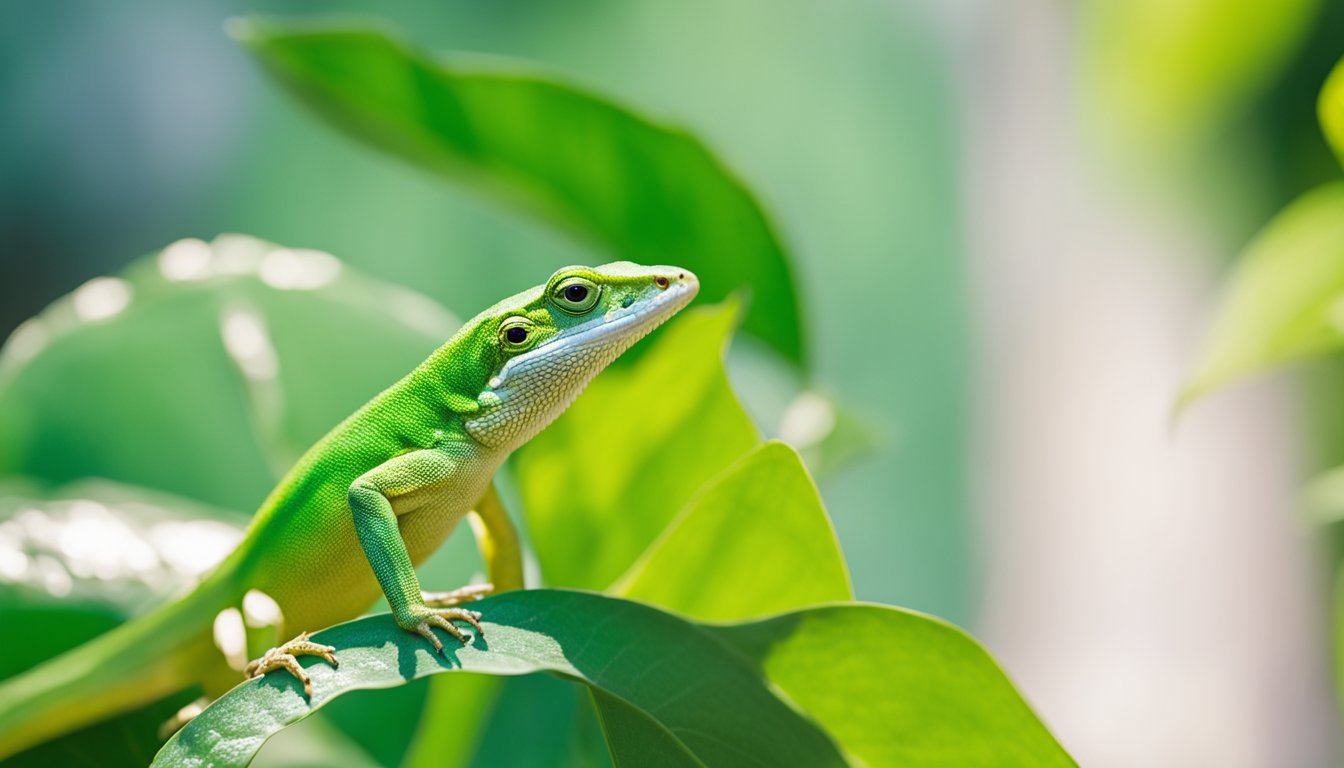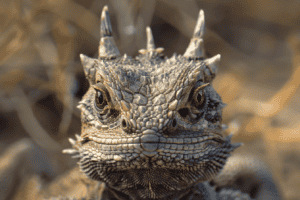Imagine tiny dinosaurs not in the pages of history books, but alive, inching around in the foliage of your own backyard.
That’s right; the green anole could very much be considered a pint-sized modern relative of the majestic creatures that once ruled the Earth.
These vibrant lizards, sporting emerald skins and nimble bodies, are a common sight in the southeastern United States, often seen scampering up trees or basking on sunny rocks.

Green anoles are remarkable, not just for their dinosaur-like lineage, but for their fascinating behaviors and adaptations.
They can change color to blend in with their surroundings, shifting from bright greens to subdued browns.
This incredible ability, similar to a chameleon’s, helps them evade predators and become skillful hunters in their own right.
It’s a survival tactic that has served them well throughout their evolution.
These lively reptiles are more than just backyard critters; they’re a key part of the ecosystem.
They play an important role in controlling insect populations, and their daily routines are a dance of survival and adaptation.
Observing them can be a wonderful introduction to the complex web of local biodiversity.
Watching an anole hunt its prey with patience and precision can be an exciting window into the natural world’s intricacies for observers both young and old.
Meet the Green Anole
Imagine coming face-to-face with a creature that has relatives dating back to the time of dinosaurs.
The Green Anole, a small lizard found across the southeastern United States, presents just such an opportunity.
Physical Characteristics Of Green Anoles
With their slender bodies and sticky toe pads, Green Anoles are acrobatic lizards perfectly designed for life in the trees.
Adults generally boast a length of 5 to 8 inches, with about half of that being their slender tails.
These anoles can change their color from a bright leafy green to a dull brown, helping them camouflage with their surroundings—an incredible trick to watch!
On the back of their heads and onto their necks, males feature a distinctive flap of skin known as a dewlap, used for display rituals.
This dewlap can vary in color from pink to white.
Habitat and Distribution
Green Anoles claim the warm climates of the southeastern United States as their backyard, making their homes in a variety of environments.
They prefer places where they can bask in the sun and forage for insects.
You’ll often spot them adorning not only trees and shrubs but also fences and building exteriors in suburban neighborhoods.
Beyond the U.S., these lizards are natives to islands in the Caribbean, showing they are quite adaptable survivors when it comes to their living quarters!
The Life of Green Anoles
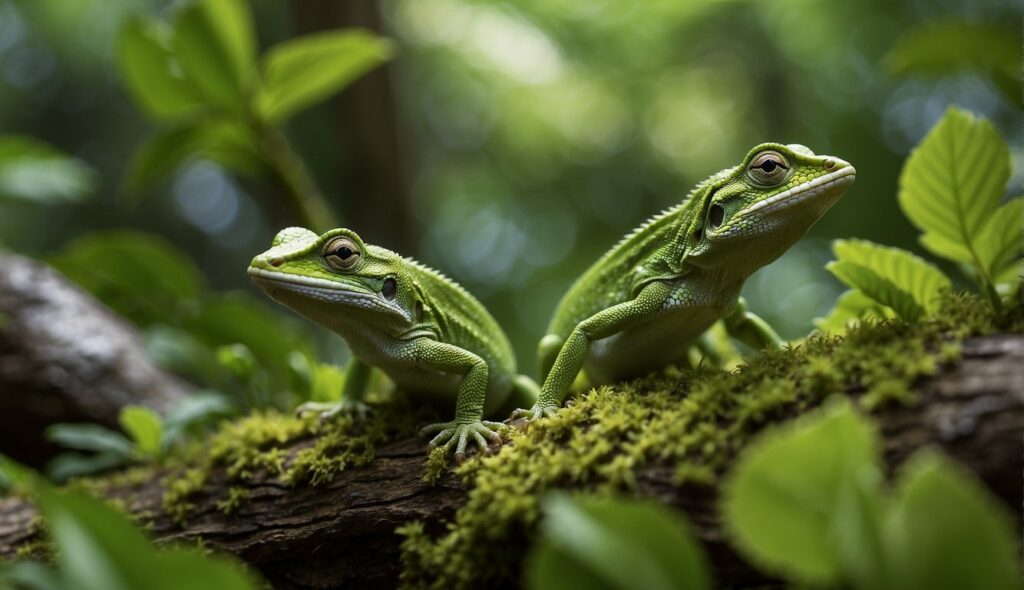
Green anoles are fascinating creatures with distinct behaviors and survival tactics. T
hey demonstrate a robust versatility in their diet and skills in hunting, have unique mating rituals, and utilize clever tactics to endure in their habitats.
Diet and Hunting Habits Of Green Anoles
Green anoles primarily feast on a variety of insects and arthropods.
Their diet consists of crickets, flies, moths, and other small invertebrates which they skillfully hunt using their keen vision.
At times, they may consume other smaller lizards or even plant matter. The green anole’s hunting strategy involves a mix of patience and speed.
They often wait motionless, blending into their surroundings until an unsuspecting victim strays too close.
Then, in a swift move, they snatch their prey using their sticky tongue.
Mating and Reproduction
Mating season for green anoles is a time of vibrant displays and keen competition among males.
During this period, males court females by extending their colorful dewlaps, a throat fan, and performing head bobs.
After mating, females lay single eggs in secluded, moist areas, usually every two weeks, to ensure the continuation of their lineage.
These eggs are laid in the soil or leaf litter and require no parental care.
The young are independent upon hatching, ready to climb and hunt, miniature replicas of their adult counterparts.
Survival Tactics
Survival for green anoles entails more than just evading predators; it involves adaptation.
They are known for their ability to change color from bright green to brown, aiding in camouflaging with their environment—a tactic to evade detection from predators such as birds and larger reptiles.
Furthermore, their slender bodies and adhesive toe pads allow them to navigate a variety of surfaces, from tree branches to glass windows, with ease.
They also exhibit territorial behavior, with males often engaging in aggressive displays to ward off competitors and protect their domain.
Humans and Green Anoles
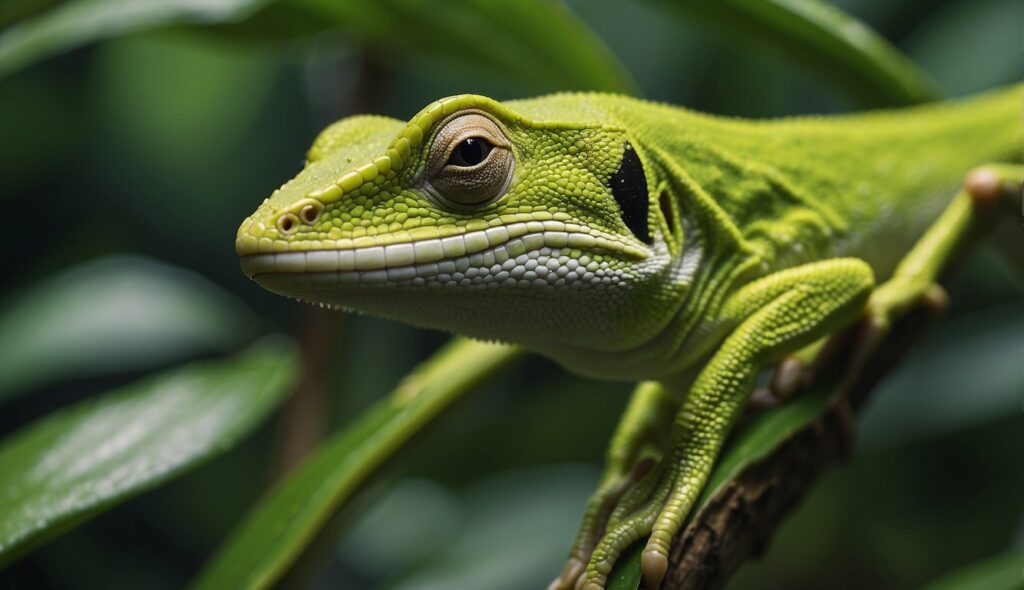
In the dance of daily life, green anoles and humans are partners in an intricate ballet.
These little lizards have adapted to life around human dwellings, and many have been invited into our homes as exotic pets.
Green Anoles in Captivity
Green anoles captivate hearts as popular pets for enthusiasts and beginners alike due to their small size and relatively simple needs.
They require a warm, humid habitat with plenty of climbing space, reflecting their natural arboreal lifestyle.
Hobbyists provide them with a diet of live insects and an environment enriched with plants and branches, allowing these green creatures to thrive under human care.
Education on their proper care is critical, whereas inadequate knowledge or commitment can lead to stress and health issues in captive anoles.
Conservation Status
Graciously gliding across leaves in their native habitats, green anoles are classified as a species of least concern by the International Union for Conservation of Nature (IUCN).
However, their wild populations are not without threats.
Habitat loss due to urban expansion, pollution, and competition from invasive species, particularly the brown anole, are challenges they face.
As stewards of their environment, humans have the responsibility to help maintain the balance by supporting conservation efforts and respecting the natural ecosystems where these miniature modern-day dinosaurs roam.
Frequently Asked Questions About Green Anoles
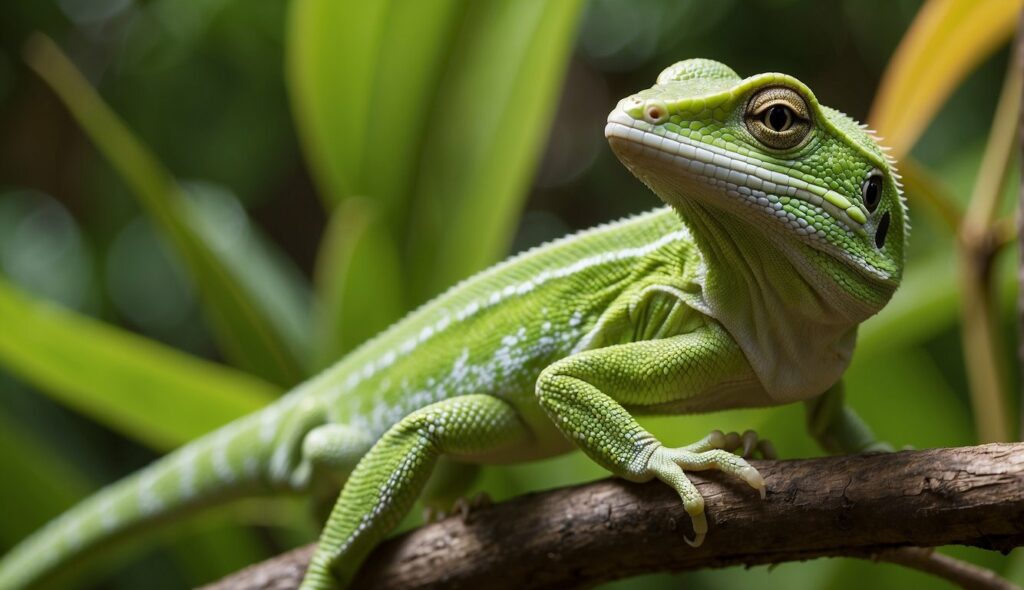
How do green anoles adapt to their environments and what changes have they undergone?
The green anole, a small and agile lizard, has the remarkable ability to change its skin color from bright green to dark brown.
This adaptation helps it blend into its environment, whether it’s lush leaves or rough bark.
Over time, they’ve honed their climbing skills, with adhesive toe pads allowing them to scale smooth surfaces with ease, helping them escape predators and catch their unsuspecting prey.
What fascinating behaviors do green anoles exhibit in their natural habitat?
These charismatic lizards are avid sunbathers, absorbing heat to power through their days.
They perform a unique display called “dewlapping” where they flash a vibrant throat fan to ward off rivals or attract a mate.
Observers might catch them bobbing their heads or doing push-ups to communicate with other anoles, making their daily interactions seem like a miniature dance-off.
Can you tell me how lizards like the green anole are connected to ancient dinosaurs?
Green anoles share a distant common ancestor with the mighty dinosaurs, hailing back to the age of reptiles millions of years ago.
They carry forward the legacy of scaled skin, egg-laying, and other reptilian traits.
Their very existence is a living reminder of prehistoric times, giving us a glimpse into the age of the dinosaurs with every flick of their slender tails.
What kind of challenges do green anoles face in places like Florida?
In the Sunshine State, green anoles are losing ground to invasive species, like the brown anole, which competes for resources and habitat.
They also face threats from habitat destruction and pollution.
Adapting to these changes is an ongoing struggle for these lizards as they try to outwit competition and thrive in increasingly urbanized landscapes.
What animals are known to hunt green anoles, and how do the anoles avoid them?
Birds of prey, snakes, and even larger lizards find green anoles to be a tasty treat.
These clever lizards use their color-changing ability and swift movements to evade capture.
By staying still and matching their surroundings, they often go unnoticed, and their speed can be the difference between becoming a meal or living to see another day.
Aside from birds, like chickens, which modern animals share a lineage with dinosaurs?
Believe it or not, crocodiles are close relatives of the dinosaurs, sharing a more recent common ancestor with them than any other living group.
These ancient reptiles have maintained many features from their prehistoric cousins, and like the dinosaurs, they’ve continued to be apex predators in their aquatic habitats, embodying a formidable lineage that has persisted through the ages.

